| Click here for Home Page to see List of All My Trips and Three Methods to search my Travelogue website for web pages of interest to you |
| Go To See Alaska - Part 7 - Kenai Fjords National Park |
In case if you see overlapped lines of text or some lines of text become obscured behind a picture on this web
page, please change the page magnification (zoom) factor to eliminate such problems by pressing these two
keys "Ctrl +" simultaneously or these two keys "Ctrl -" simultaneously.
Please press the F11 key on your keyboard to get full-screen view of photos and web page. Pressing F11 key
again will return to your normal screen with various tool bars.
page, please change the page magnification (zoom) factor to eliminate such problems by pressing these two
keys "Ctrl +" simultaneously or these two keys "Ctrl -" simultaneously.
Please press the F11 key on your keyboard to get full-screen view of photos and web page. Pressing F11 key
again will return to your normal screen with various tool bars.
風光明媚, 山光水色是如此迷人 。
Scenery viewed from cruise ship in Kenai Fjords National Park
Map: Click here to see Google Map showing location of Kenai Fjords National Park
Scenery viewed from cruise ship in Kenai Fjords National Park
Map: Click here to see Google Map showing location of Kenai Fjords National Park
明淨清澈的海水。
There were many small groups of sea birds flying this way and that way just above the water surface
as our tour ship cruised along the fjord.
There were many small groups of sea birds flying this way and that way just above the water surface
as our tour ship cruised along the fjord.
Part 8 of 11 is about Denali National Park with very impressive mountains, tundra and many kinds of wildlife. It
is at:
http://www.shltrip.com/Go_To_See_Alaska_Part_8_Denali.html
is at:
http://www.shltrip.com/Go_To_See_Alaska_Part_8_Denali.html
鯨魚忽然躍出海面, 騰空而起。
Suddenly, a whale jumped out (breaching) of the water to the right of our ship. It happened so fast that I was
busy taking pictures of those birds flying above the hot spot and did not have enough time to swing my camera
fast enough to get that whale in the air in focus and in the middle of my picture frame.
Suddenly, a whale jumped out (breaching) of the water to the right of our ship. It happened so fast that I was
busy taking pictures of those birds flying above the hot spot and did not have enough time to swing my camera
fast enough to get that whale in the air in focus and in the middle of my picture frame.
鯨魚或以巨頭竄出海面,或以大尾擊水, 此起彼伏,壯觀非凡。
Another whale came up more gently this way.
Another whale came up more gently this way.
鯨魚呼氣噴出的水柱又細又高,富有韻味。
A whale spouting. (We also saw such whale spouting several times when we were on Sapphire Princess Cruise
ship several days ago in or near Glacier Bay National Park and College Fjord.)
During feeding, pleated grooves in the throat of humpback whale expand enabling it to gulp large mouthfuls of
water and fish. When the whale closes its mouth, the water is forced out. The baleen plates act as filters,
trapping many fish on the inside ready to be swallowed.
After about half an hour of such feeding activities of several humpback whales in this area, probably all the fish
in that big group in this area were all gulped up by the whales. Therefore, all those sea birds flew away and
none could be seen in this area any more. Our ship then moved on to other areas.
A whale spouting. (We also saw such whale spouting several times when we were on Sapphire Princess Cruise
ship several days ago in or near Glacier Bay National Park and College Fjord.)
During feeding, pleated grooves in the throat of humpback whale expand enabling it to gulp large mouthfuls of
water and fish. When the whale closes its mouth, the water is forced out. The baleen plates act as filters,
trapping many fish on the inside ready to be swallowed.
After about half an hour of such feeding activities of several humpback whales in this area, probably all the fish
in that big group in this area were all gulped up by the whales. Therefore, all those sea birds flew away and
none could be seen in this area any more. Our ship then moved on to other areas.
Fins of three or more killer whales. We heard that salmon is so numerous here that they bump into your boat.
Killer whales in Kenai Fjord generally travel in pods and feed on salmon, seals, birds and other mammals.
Killer whales in Kenai Fjord generally travel in pods and feed on salmon, seals, birds and other mammals.
Many puffins are nesting on the bird island. They breed in large colonies on offshore islands, nesting in burrows
in the soil among the rocks or the cliff. Here one can see these puffins are standing at the entrances of the
burrows of their nests. Puffins build their nests inside burrows (tunnels) for protection because other larger birds
prey on puffins.
in the soil among the rocks or the cliff. Here one can see these puffins are standing at the entrances of the
burrows of their nests. Puffins build their nests inside burrows (tunnels) for protection because other larger birds
prey on puffins.
On the other hand, Kittiwake prefer to nest on the cliff ledges of the bird islands as shown above.
We also saw murres perching precariously on narrow ledges on other parts of the bird islands.
The experience here with these large bird rookeries is similar to what we saw on a bird island in Newfoundland
in eastern Canada as shown on my Travelogue web page at:
http://www.shltrip.com/Birds_Islands_Newfoundland.html
We also saw murres perching precariously on narrow ledges on other parts of the bird islands.
The experience here with these large bird rookeries is similar to what we saw on a bird island in Newfoundland
in eastern Canada as shown on my Travelogue web page at:
http://www.shltrip.com/Birds_Islands_Newfoundland.html
Then suddenly those sea birds in feeding frenzy on the water surface took off into the air indicating that
something big was happening under the water and near the surface to scare those birds to get off from the
water surface into the air.
something big was happening under the water and near the surface to scare those birds to get off from the
water surface into the air.


讓人感覺清涼舒暢的青山綠水, 將心靈洗滌得澄清明淨 。
Pristine blue green water in Kenai Fjords National Park
On the morning of August 20, 2009, we took the 6-hour cruise from Seward Harbor to tour the Kenai Fjords
National Park. The tour ship has a capacity for about 150 tourists and has 2 levels. It is a high-speed
catamaran cruise ship.
Pristine blue green water in Kenai Fjords National Park
On the morning of August 20, 2009, we took the 6-hour cruise from Seward Harbor to tour the Kenai Fjords
National Park. The tour ship has a capacity for about 150 tourists and has 2 levels. It is a high-speed
catamaran cruise ship.


Then our tour ship came to a hot-spot where there was a feeding frenzy of concentration of very large number
of sea birds on the water surface. It was an indication of a large group of small fish (bait fish, most likely
herring) in the water and near the water surface such that those sea birds could catch those small fish easily.
There probably were some large predators under the water chasing and driving the large group of small fish to
the water surface.
of sea birds on the water surface. It was an indication of a large group of small fish (bait fish, most likely
herring) in the water and near the water surface such that those sea birds could catch those small fish easily.
There probably were some large predators under the water chasing and driving the large group of small fish to
the water surface.

無數的小魚跳躍游動海面, 圈圈點點成漣漪。
Many small fish were jumping and making circular ripples on the water surface. I pointed my camera down into
the water. One could see some small fish in the water and the white color area on the lower left corner might
be the pectoral flipper (fin) of a humpback whale chasing the school of small fish.
Many small fish were jumping and making circular ripples on the water surface. I pointed my camera down into
the water. One could see some small fish in the water and the white color area on the lower left corner might
be the pectoral flipper (fin) of a humpback whale chasing the school of small fish.
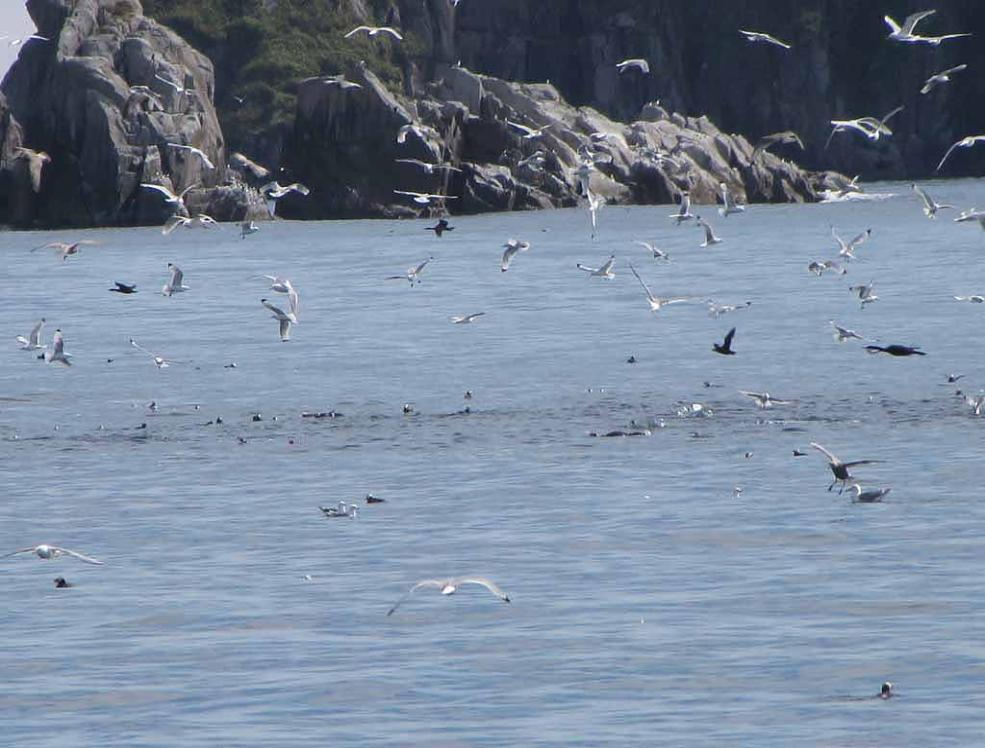



躍出海面的鯨魚,帶著雷鳴般的巨響,橫著又落入水中,激起飛濺的
大浪花,驚心動魄 ,“鯨魚!鯨魚!”人們不約而同的歡呼,終生難忘
Then the whale came down with a big splash
大浪花,驚心動魄 ,“鯨魚!鯨魚!”人們不約而同的歡呼,終生難忘
Then the whale came down with a big splash


We also saw the tails, the backs and the heads of several (humpback) whales very active in this area.





A distance view of the enormous Bear Glacier which is the largest glacier in the Kenai Fjords National Park.
This picture was taken from inside the tour ship through a window and has some reflections of lights inside the
ship. (四周秀美的雪山景觀)
Map: Click here to see Google Map showing Satellite View of Bear Glacier and the massive Harding Ice Field
This picture was taken from inside the tour ship through a window and has some reflections of lights inside the
ship. (四周秀美的雪山景觀)
Map: Click here to see Google Map showing Satellite View of Bear Glacier and the massive Harding Ice Field

Then we came to an area with a group (pod) of killer whales (Orca).




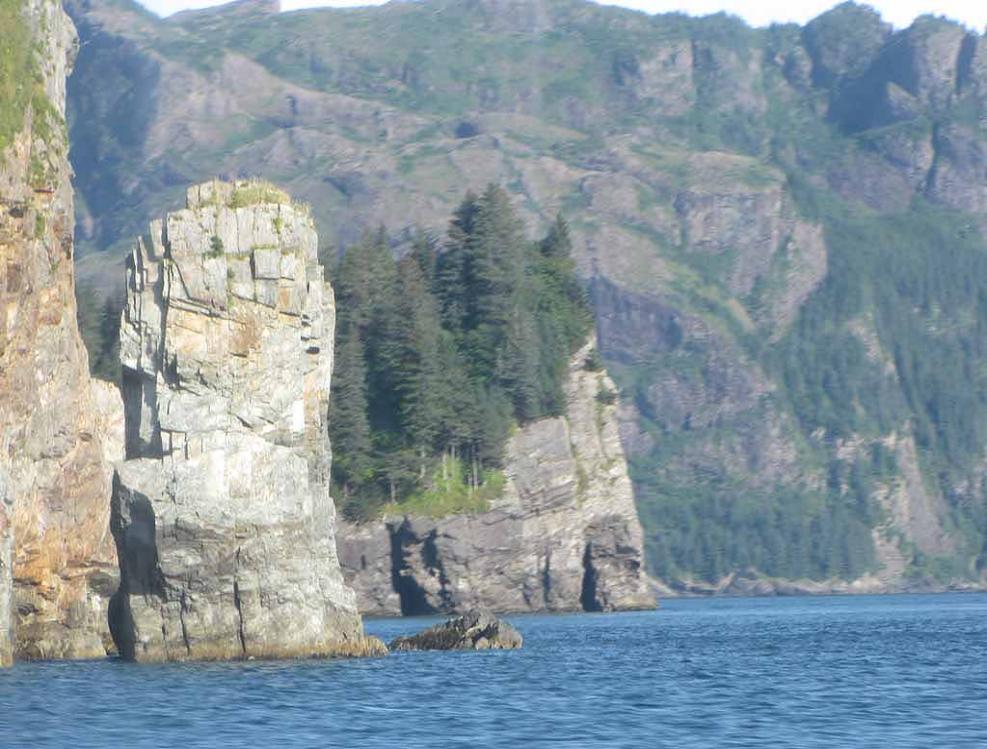








海闊憑魚躍,天高任鳥飛,成千上萬漫天飛鳥,密密麻麻的飛進飛
出。
Then our ship came near two tall bird islands (probably Chiswell Islands in the Alaska Maritime
National Wildlife Refuge) where the whole sky is filled with many sea birds busily flying and swirling in
and out of the bird islands. Each tiny black dot on these two pictures is a sea bird in flight because
they are flying very high due to the hight of these two tall bird islands. During the summer breeding
season, tens of thousands of sea birds come here to lay eggs and to raise their chicks on the bird
islands. Abundance of fish in nearby water provides the necessary food source for these sea birds
and their chicks.
Map: Click here to see Google Map showing location of Chiswell Islands
出。
Then our ship came near two tall bird islands (probably Chiswell Islands in the Alaska Maritime
National Wildlife Refuge) where the whole sky is filled with many sea birds busily flying and swirling in
and out of the bird islands. Each tiny black dot on these two pictures is a sea bird in flight because
they are flying very high due to the hight of these two tall bird islands. During the summer breeding
season, tens of thousands of sea birds come here to lay eggs and to raise their chicks on the bird
islands. Abundance of fish in nearby water provides the necessary food source for these sea birds
and their chicks.
Map: Click here to see Google Map showing location of Chiswell Islands
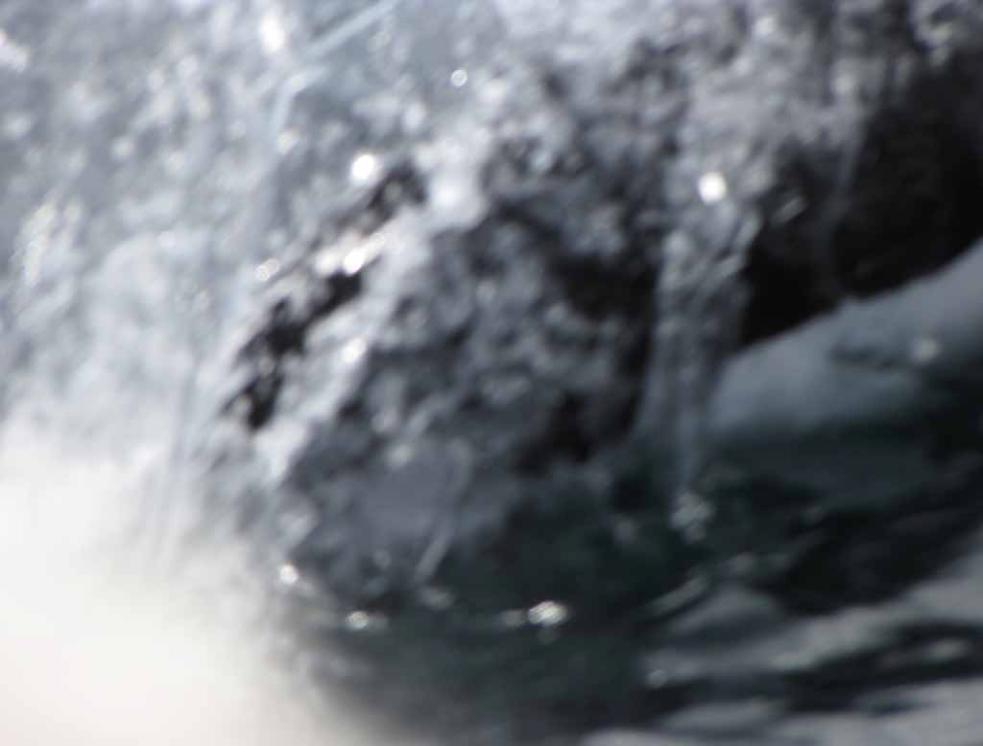
A killer whale breaking out of water not too far from our ship. Again, it happened so fast that I did not have time
to focus this picture well.
We also saw some very playful porpoises racing our high-speed cruise ship in front of and on the side of our
ship.
to focus this picture well.
We also saw some very playful porpoises racing our high-speed cruise ship in front of and on the side of our
ship.


Two sample pictures of many puffins on the water near the bird islands. These are pelagic seabirds that feed
primarily by diving into the water to catch fish.
primarily by diving into the water to catch fish.

These puffins were often running on the water surface to take off as shown in these two pictures. It is some
what similar to an airplane roaring down a runway to take off. This is probably due to the need of puffin for
high speed to get enough lift from their small wings.
As a contrast, an osprey (fish hawk) can just flap its large wings to lift itself out of water and into the air
without the need of any horizontal speed. The large wings also enable the osprey to hover in mid-air, like an
helicopter, without any horizontal speed.
what similar to an airplane roaring down a runway to take off. This is probably due to the need of puffin for
high speed to get enough lift from their small wings.
As a contrast, an osprey (fish hawk) can just flap its large wings to lift itself out of water and into the air
without the need of any horizontal speed. The large wings also enable the osprey to hover in mid-air, like an
helicopter, without any horizontal speed.
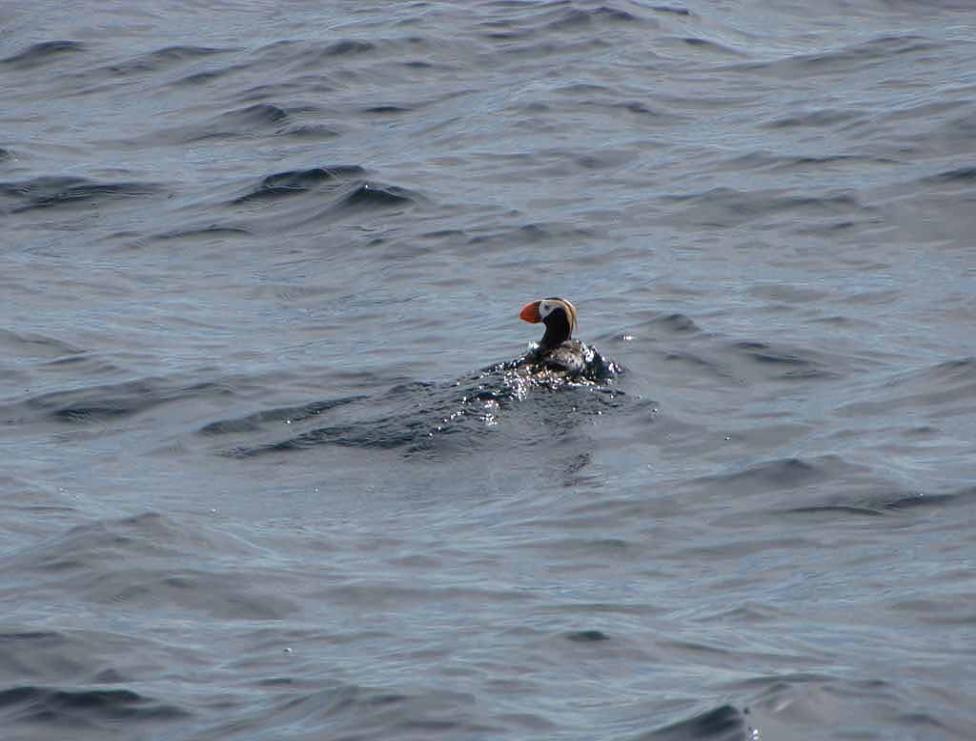


One of many puffins in flight near the bird islands. It was not easy to take good pictures of these busy puffins
in flight because they fly very fast, almost like shooting arrows in various random directions above you, beside
you and under you. These seabirds, such as puffins, fly at speed up to 55 miles per hour and flap their wings
up to 400 times per minute. Puffins use their wings to fly not only in the air, but also under water to chase and
catch fish. Puffins can swim to depth of 200 feet under water. Their small wings are a compromise between
flying in the air and flying under water. Because of their small wings they have to fly very fast in the air to get
enough lift. In this strange and wonderful place, birds swim better than they fly.
in flight because they fly very fast, almost like shooting arrows in various random directions above you, beside
you and under you. These seabirds, such as puffins, fly at speed up to 55 miles per hour and flap their wings
up to 400 times per minute. Puffins use their wings to fly not only in the air, but also under water to chase and
catch fish. Puffins can swim to depth of 200 feet under water. Their small wings are a compromise between
flying in the air and flying under water. Because of their small wings they have to fly very fast in the air to get
enough lift. In this strange and wonderful place, birds swim better than they fly.
Many seabirds are busily flying in-and-out of the bird islands to catch fish in the nearby water to go back to
feed their chicks in their nests on the bird islands. There were masses of seabirds at the bird Islands;
crowded and it looks like a bee hive of activity. Therefore, these two bird islands are often referred to as
Beehive Islands.
feed their chicks in their nests on the bird islands. There were masses of seabirds at the bird Islands;
crowded and it looks like a bee hive of activity. Therefore, these two bird islands are often referred to as
Beehive Islands.



Then our tour ship moved on to other areas.




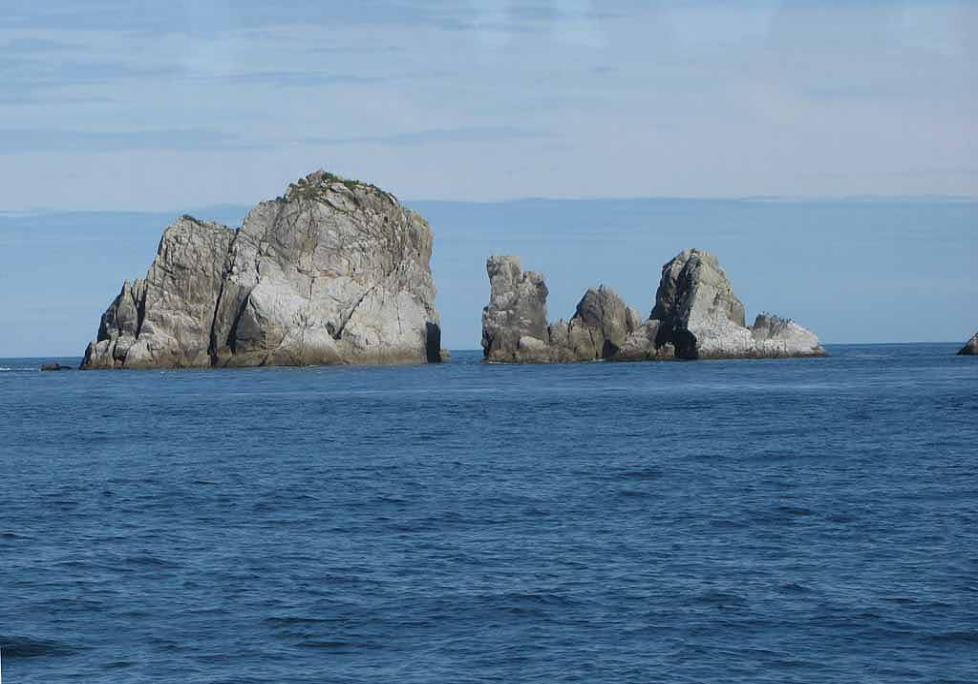

Several cormorants and gulls on rocks.

We also saw many harbor seals.

Then the tour ship took us to see the Holgate Glacier which is similar to what we saw in Glacier Bay National
Park and College Fjord several days ago on Sapphire Princess Cruise ship.
Map: Click here to see Google Map showing location of Holgate Glacier
Park and College Fjord several days ago on Sapphire Princess Cruise ship.
Map: Click here to see Google Map showing location of Holgate Glacier

冰川崩塌轟轟烈烈的精彩情景。
There were also calving of the Holgate Glacier with very loud noise.
Above this glacier is the huge Harding Icefield with ice several thousand feet thick. Up to 40 glaciers
descend down in various directions from this massive icefield.
On our return cruise from Holgate Glacier back to Seward, we saw again several hot-spots with high
concentration of sea birds in feeding frenzy on water surface that might attract whales for follow on
feeding actions.
There were also calving of the Holgate Glacier with very loud noise.
Above this glacier is the huge Harding Icefield with ice several thousand feet thick. Up to 40 glaciers
descend down in various directions from this massive icefield.
On our return cruise from Holgate Glacier back to Seward, we saw again several hot-spots with high
concentration of sea birds in feeding frenzy on water surface that might attract whales for follow on
feeding actions.
There were 9-hour cruise and 6-hour cruise for two different fjords in Kenai Fjord National Park. There are
three or more tour ship companies in Seward Harbor for tourists to choose from. However, the Alaska
TourSaver coupon can be used on only the 6-hour tour of one of the three companies. That was how we ended
up choosing the 6-hour tour to get the 50% discount by using the Buy-One-Get-One-Free or 2-for-1 type of
discount coupon. We made reservation several weeks ahead to make sure that we would have the seats
when we arrived.
The sequence of our 2-week Tour of Alaska is the Following:
One-week Alaska Cruise:
Vancouver in Canada, the starting point of 1-week Alaska Cruise --------> Ketchikan in Alaska (Misty Fjords
National Monument) --------> Juneau (Mendenhall Glacier, Macaulay Salmon Hatchery, Gold Creek Salmon
Bake) ---------> Skagway (8-hour Excursion Land Tour into Yukon Territory in northwest Canada) -------->
Glacier Bay National Park --------> College Fjords --------> Whittier, the end point of our Alaska Cruise.
One-week driving tour of Alaska starts from Whittier as follows:
Whittier --------> Denali National Park --------> Fairbanks (Creamer's Field Migratory Waterfowl Refuge,
Georgeson Botanical Garden, Large Animal Research Station of the University of Alaska) ---------> Town of
North Pole --------> Scenic Richardson Highway going south --------> Boundary of Wrangell-St Elias National
Park ---------> Scenic Glen Highway going west ---------> Scenic Seward Highway going south -------->
Seward, (Kenai Fjords National Park, Exit Glacier) --------> Seward Highway going north to Tern Lake, then
Sterling Highway going west to Kenai, then south ---------> Homer --------> Sterling Highway going north to
Kenai, then east, to Tern Lake, then Seward Highway going north ---------> Alaska Wildlife Conservation
Center --------> Anchorage, the end point of our driving tour of Alaska
three or more tour ship companies in Seward Harbor for tourists to choose from. However, the Alaska
TourSaver coupon can be used on only the 6-hour tour of one of the three companies. That was how we ended
up choosing the 6-hour tour to get the 50% discount by using the Buy-One-Get-One-Free or 2-for-1 type of
discount coupon. We made reservation several weeks ahead to make sure that we would have the seats
when we arrived.
The sequence of our 2-week Tour of Alaska is the Following:
One-week Alaska Cruise:
Vancouver in Canada, the starting point of 1-week Alaska Cruise --------> Ketchikan in Alaska (Misty Fjords
National Monument) --------> Juneau (Mendenhall Glacier, Macaulay Salmon Hatchery, Gold Creek Salmon
Bake) ---------> Skagway (8-hour Excursion Land Tour into Yukon Territory in northwest Canada) -------->
Glacier Bay National Park --------> College Fjords --------> Whittier, the end point of our Alaska Cruise.
One-week driving tour of Alaska starts from Whittier as follows:
Whittier --------> Denali National Park --------> Fairbanks (Creamer's Field Migratory Waterfowl Refuge,
Georgeson Botanical Garden, Large Animal Research Station of the University of Alaska) ---------> Town of
North Pole --------> Scenic Richardson Highway going south --------> Boundary of Wrangell-St Elias National
Park ---------> Scenic Glen Highway going west ---------> Scenic Seward Highway going south -------->
Seward, (Kenai Fjords National Park, Exit Glacier) --------> Seward Highway going north to Tern Lake, then
Sterling Highway going west to Kenai, then south ---------> Homer --------> Sterling Highway going north to
Kenai, then east, to Tern Lake, then Seward Highway going north ---------> Alaska Wildlife Conservation
Center --------> Anchorage, the end point of our driving tour of Alaska
We saw several large colonies of sea lions sun bathing on rocks.
Wildlife is abundant throughout the Kenai Fjords National Park, and the tidewater glaciers in this national park
are massive as shown in the following photos that I took of up close encounters with wildlife (雪山環抱,風景優
美 ).
The cruise tour is narrated by a National Park Ranger, who is highly adept at spotting wildlife, pointing out the
many spectacular sights, and answering many questions from the tourists on the ship.
are massive as shown in the following photos that I took of up close encounters with wildlife (雪山環抱,風景優
美 ).
The cruise tour is narrated by a National Park Ranger, who is highly adept at spotting wildlife, pointing out the
many spectacular sights, and answering many questions from the tourists on the ship.

Many tourists got out on the deck at the front end of the ship to watch all these exciting close encounters with
various wildlife.
various wildlife.
許多造型特殊的奇岩異石的海灣。
碧藍的海水, 氣勢磅礴的海岸線, 令人難忘的碧藍和純淨。
多采多姿的海岸形態, 高叢的懸崖,每一塊礁石、每一座海崖,都有
它獨特的型態線條,加上碧藍的海水,構成一幅最美的海岸風情畫。
它獨特的型態線條,加上碧藍的海水,構成一幅最美的海岸風情畫。
碧波蕩漾、風光秀麗。
鯨魚呼氣噴出的水柱。
| 讀萬卷書 行萬里路 |
